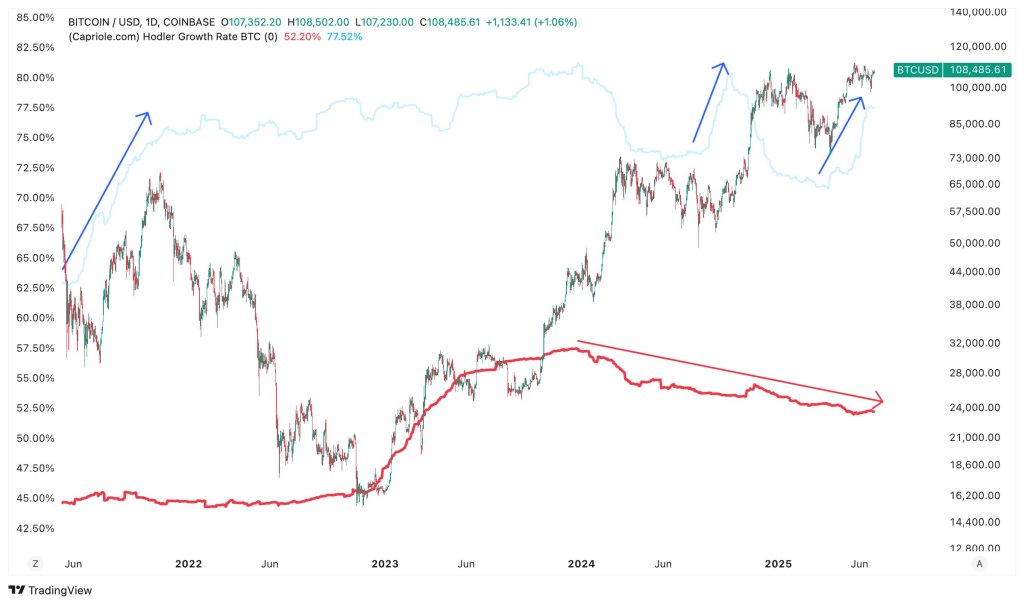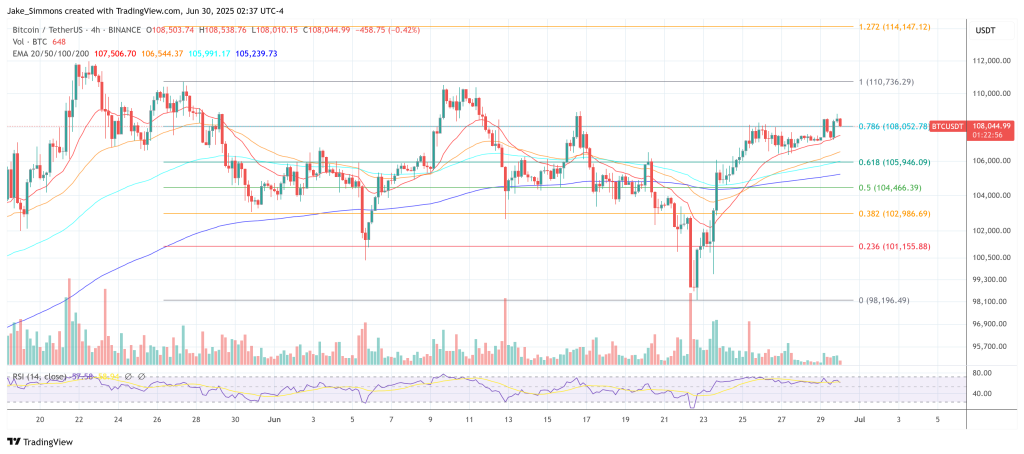Motive to belief
Strict editorial coverage that focuses on accuracy, relevance, and impartiality
Created by business specialists and meticulously reviewed
The very best requirements in reporting and publishing
Strict editorial coverage that focuses on accuracy, relevance, and impartiality
Morbi pretium leo et nisl aliquam mollis. Quisque arcu lorem, ultricies quis pellentesque nec, ullamcorper eu odio.
Whereas Bitcoin continues to hover above the $100,000 threshold, the driving forces behind this historic consolidation section look like extra complicated than the surface-level narratives of institutional “FOMO” and ETF euphoria. In response to a number of main analysts, a silent rotation is underway—one that means long-term holders are offloading their positions whereas company treasuries and institutional consumers quietly take in the flood.
OG Bitcoin Whales Are ‘Dumping’ On Wall Street
Charles Edwards, founding father of Capriole Investments, delivered a sobering breakdown by way of X on June 29, difficult the prevailing perception that Bitcoin’s worth stagnation amid surging demand is anomalous. “People are wondering why BTC has been stuck at $100K so long, despite the institutional FOMO,” he wrote. “Despite what X news might suggest, it’s because Bitcoin OGs (long-term holders) have been dumping on Wall St since the ETF Launch in January 2024, unloading their positions.”
Edwards, identified for mixing on-chain metrics with macro frameworks, pointed to a visual dynamic shift that’s now being captured in blockchain knowledge. Whereas older cash are being redistributed, a more recent class of holders—primarily treasury-oriented entities—are stepping in aggressively. “We have clearly entered the heat of [the Treasury Company] trend today as many copy-cats have entered the market,” he mentioned, referencing his earlier prediction on Bits and Bips that company adoption would ultimately eclipse ETF inflows in relevance.
What makes this transition significantly outstanding is the information behind it. Edwards highlighted that 6-month-plus BTC holders—generally related to extra strategic, non-speculative accumulation—have skyrocketed prior to now two months. “The amount of BTC acquired in the last 2 months by this cohort has completely consumed all of the BTC unloaded by LTHs over the last 1.5 years,” he mentioned. “Incredible.”
Associated Studying
This cohort’s aggressive accumulation, he added, has traditionally preceded bullish squeezes. “Whenever aggressive spikes in 6M+ holders occur, price usually squeezes following these periods. Short-term bullish,” Edwards remarked. Nonetheless, he tempered the optimism by cautioning that broader on-chain knowledge nonetheless alerts fragility. “If the 6M+ holders (Treasury Companies) can continue their relentless buying, that should be achievable,” he famous, signaling that the flywheel has momentum, however will not be but proof against systemic strain.

Including one other layer to this growing narrative, Mauricio Di Bartolomeo, Co-founder and CSO at Ledn, supplied an alternate idea. He recommended that what seems as two flows—LTHs promoting and Treasury entities shopping for—would possibly in truth be “the same trade.” He wrote, “Long term holders [are] selling spot to buy ETFs/BTC Treasury Cos. Even though that feels unnatural for us bitcoiners.” Di Bartolomeo framed the shift as generational, mentioning that many early adopters might merely be extra comfy in conventional monetary custody somewhat than self-sovereign wallets.
Associated Studying
However Edwards pushed again on that clarification, arguing that if ETF migration was driving the reclassification of long-term holders, it could be evident throughout a number of growing old cohorts. “I don’t think so because we would have seen a similar uptrend over time in the 6M+ and 1Yr+ cohorts if that was the case,” he replied. “Some is definitely moving to equities, but it’s very typical of this stage of the Halving cycle to see LTH selling into profit.”
Why Bitcoin ETF Do Not Have A 1:1 Impact On Worth
The obvious dissonance between rising demand and stagnant worth has additionally prompted commentary from on-chain analyst TXMC, who warned that almost all observers misunderstand what truly units Bitcoin’s worth. “Bitcoin people grossly underestimate how little of the supply is actually setting the price every hour,” he wrote. He described Bitcoin’s fragmented market construction as an online of siloed exchanges, loosely synchronized via cross-exchange market-making. “Each location has its own liquidity and depth which vary wildly. A large market order can have an outsized effect depending on which exchange it is placed at, and which time of day.”
TXMC argued that whereas ETFs and institutional desks are accumulating massive portions of Bitcoin, a lot of this exercise is routed via OTC desks that bypass order books fully. “These actions do not affect the price in the same way,” he mentioned. “The desks source their own liquidity, and only have to go into the books to fill the difference.”
This clarification might assist reconcile why ETF inflows within the billions of {dollars} have didn’t push BTC considerably larger. Edwards’ thesis aligns with this too, insofar because the ETF growth could also be fueling redistribution somewhat than outright internet demand. TXMC added: “Stop underestimating how many big entities are out there looking for exit liquidity.”
Regardless of rising bullishness in cohort composition, the actual check lies forward. Whether or not company treasuries and ETF managers can take in the remaining exit waves of Bitcoin’s earliest holders stays to be seen. But when Edwards is correct, the rotation might already be previous its essential section.
“The flywheel still has a long way to go,” Edwards concluded. And if historical past is any information, these moments of consolidation amid redistribution are likely to precede volatility—not comply with it.
At press time, BTC traded at $108,044.

Featured picture created with DALL.E, chart from TradingView.com


